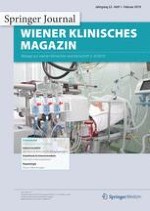Erschienen in:

10.01.2019 | Innere Medizin | Anästhesie & Intensivmedizin
Delir beim Intensivpatienten
Eine multiprofessionelle Herausforderung
verfasst von:
Priv.-Doz. Dr. Norbert Zoremba, Ph.D., Prof. Dr. Marc Coburn, Priv.-Doz. Dr. Gereon Schälte
Erschienen in:
Wiener klinisches Magazin
|
Ausgabe 1/2019
Einloggen, um Zugang zu erhalten
Zusammenfassung
Delir ist die häufigste Form einer zerebralen Dysfunktion bei Patienten auf der Intensivstation und ein medizinischer Notfall, der vermieden oder zeitnah diagnostiziert und therapiert werden muss. Nach heutigem Kenntnisstand scheint die Entwicklung eines Delirs durch ein Zusammenspiel von erhöhter Vulnerabilität (Prädisposition) und der gleichzeitigen Exposition gegenüber delirogenen Faktoren bedingt zu sein. Da in der klinischen Routine ein Delir häufig übersehen wird, sollte engmaschig ein Delirscreening erfolgen. Wegen der engen Verknüpfung zwischen Delir, Agitation und Schmerz muss analog zum Delirscreening mindestens alle 8 h zusätzlich eine Evaluation der Sedierung und der Analgesie erfolgen. In der Prävention und Therapie des Delirs wird nach heutigem Kenntnisstand ein multifaktorielles und multiprofessionelles Vorgehen favorisiert. Hierbei hat die nichtmedikamentöse Intervention durch Frühmobilisation, Reorientierung, Schlafverbesserung, adäquate Schmerztherapie und Vermeidung einer Polypharmazie einen hohen Stellenwert. In der symptomorientierten medikamentösen Delirtherapie finden, in Abhängigkeit von dem klinischen Bild, unterschiedliche Substanzen Anwendung. Um diese diagnostischen und therapeutischen Ziele zu erreichen, ist ein interdisziplinäres Behandlungsteam, bestehend aus Intensivpflege, Intensivärzten, Stationsapothekern, Physiotherapeuten, Ernährungsspezialisten und Psychiatern notwendig, um den Anforderungen des Patienten und deren Angehörigen gerecht zu werden.